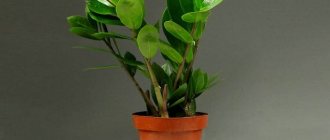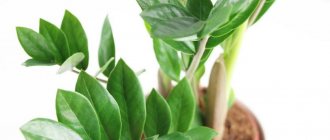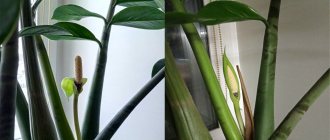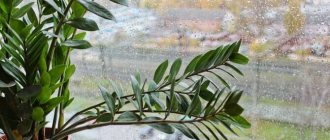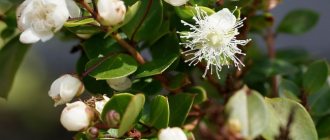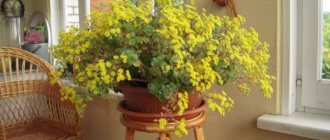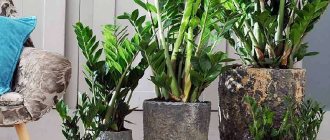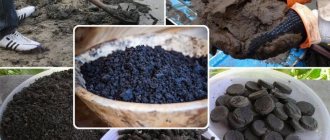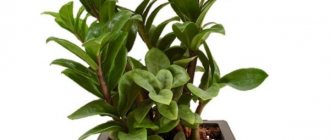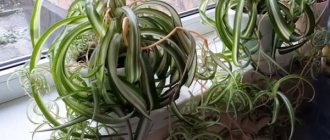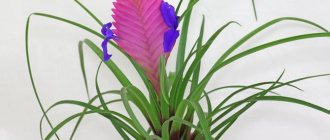This exotic handsome man won the love of Russian citizens in the late 90s. A beautiful evergreen plant appeared in Dutch nurseries. As a result, Zamioculcas settled in many apartments and offices. The flower has poisonous juice, but it does not emit any toxic fumes. Therefore, keeping it at home is completely safe.
Zamioculcas - belongs to the aroid family. This unpretentious evergreen plant in most of its characteristics is closest to succulents.
The flower has the following unique names:
- Dollar Tree;
- Currency tree;
- Money Tree;
- Eternal Tree;
- Zanzibar Pearl;
- Woman's happiness;
- Flower of celibacy.
His homeland is Africa. The plant received its unique name due to its similarity with zamia. Given its Latin roots, zamiya means loss or damage.
The flower is perfect for interior decoration because it has a pronounced external decorative effect. If good conditions are provided, the length of the plant can be up to 80 centimeters or more. Zamioculcas is a perennial, but does not live more than 10 years.
The closest “relatives” of the plant are Monstera and Dieffenbachia. Its distinctive feature is its straight-growing glossy leaves, attached to the stem by long cuttings.
Popular types
Zamioculcas appeared in flower shops 20 years ago. During this time, breeders have developed several different species, the most popular of which for home cultivation are:
Zamioculcas zamiifolia
Zamioculcas zamifolia / Flowering
This is the most typical representative of the plant . This is what refers to the “money tree”. A beautiful ornamental bush with bright fleshy leaves. The plant looks so perfect that it feels like it is artificial. An amazing plant that hides its trunk in the soil. For the first time weeks after growth, the flower does not form roots. Instead, there is a tuber that stores large reserves of water. The tuber is somewhat reminiscent of a dark marsh or brown potato. Has the shape of an ellipse.
Looking at the pot with the plant, it seems that bright green leaves are growing directly from the soil. The leaves are attached to the tuber using a long stalk, which unknowing gardeners mistake for the trunk. The length of the leaves reaches 60 centimeters . The leaves grow from a tuber and are divided into 8-12 individual leaflets. This is very rare for this species. The feather is dense, glossy and has a thick, juicy axis in which the flower stores moisture.
The plant grows in height very slowly. The cost of a shrub in a flower shop depends on its height; the longer, the more expensive.
Zamioculcas variegate
Zamioculcas variegated
Variegated or variegated Zamioculcas is very difficult to find in flower shops. His homeland is the island of Madagascar. At home it can reach a height of 1 to 1.5 meters. The leaves are arranged symmetrically in strict order. They have a bright green color, juicy flesh, and pointed ends. Flowers rarely appear on the plant, with very good care. The inflorescence is formed in the shape of a spadix.
Zamioculcas lanceolata
Zamioculcas lanceolate
Received this name because of the elongated leaves of the original lanceolate shape. The flower was first exhibited at flower auctions in Holland at the end of the 20th century. Its height reached 1.5 meters and above. In 2007, a miniature plant was bred, not exceeding 60 centimeters in height. Its leaves are an exact copy of its progenitor, only in a reduced size.
Black zamioculcas (Zamioculcas Blak)
Black Zamioculcas
The plant has leaves and cuttings of almost black color. Otherwise, it is completely similar to Zamioculcas zamifolia. The same fleshy leaves, pointed at the tips, attached symmetrically on both sides on a common stalk. The young bush has salad-colored leaves. As they mature, they begin to darken. At the same time, their color is not affected at all by the lighting in the room. No matter how the florist tries to lighten the leaves, he will not succeed. This “tree” looks very impressive. Therefore, it will perfectly decorate any room.
History of indoor culture of Zamioculcas
The first description of Zamioculcas dates back to 1828, and was given by the very famous foreign collector of tropical crops, Conrad Lodges. The plant was described as Caladium zamiifolium Lodd. More than twenty years later, Heinrich Wilhelm Schote changed this name to Zamioculcas Loddiges. And a few decades later, the director of the Berlin Botanical Garden, Adolf Engler, registered the modern, latest and more famous version of the name Zamioculcas zamiifolia today.
This evergreen tropical plant became popular as a decorative indoor crop twenty years ago, after appearing at foreign flower auctions. Ten years ago, the first miniature stump of Zamioculcas was obtained, forming a very compact plant no more than 0.5 m high with fairly small but attractive foliage.
Care
The plant does not require careful constant attention. Growing a healthy dollar tree is not difficult. In its natural habitat, the flower is accustomed to difficult growing conditions. Therefore, it is not at all capricious in care, location and choice of soil.
Also read: Aeonium home species with photos, maintenance and care
Watering
The health of the currency tree depends on proper watering. The plant is able to accumulate liquid, so it tolerates drought more easily than excess moisture. Excess moisture causes tubers to rot. Lack of moisture can be seen in the thinning of the leaves and their limp appearance. During prolonged drought, the flower may shed its leaves, especially during periods of intensive growth.
The following watering scheme should be followed:
- Spring and summer are the period of plant growth. Therefore, the flower needs extra moisture. Watering is carried out 3-4 times a month;
- Winter and autumn refer to the dormant period when the plant rests. It is necessary to reduce the frequency of watering to 1-2 times a month.
Settled water at room temperature is suitable for irrigation. Before moistening the soil, make sure the soil is completely dry. If excess water leaks into the pan, it must be drained immediately. When it stagnates, putrefactive processes begin.
Lighting
This is a light-loving plant. Although it brings great darkness. The best location is the window sill of a south window. You should not expose the flower to direct sunlight, as the leaves can get severely burned.
- It is worth hanging a small curtain on the window to create a slight oppression, especially in the summer season.
- Without good lighting, the leaves of the dollar tree become thinner. They become slightly sluggish, and the bush loses all its decorative charm.
- It is especially important to create bright lighting during the period of increased plant growth: spring and summer. In order for the growth to be uniform, you need to turn the flower towards the window with different sides, otherwise the symmetrical shape of the leaves will be absent.
The plant loves fresh air. Therefore, during the warm season it should be taken out into the garden or onto the balcony. It is first necessary to provide the eternal tree with slight shading and protection from precipitation.
Temperature
The plant comes from Africa, so it loves warmth very much. Intense heat exceeding thirty degrees will not cause any harm to the bush. Experts involved in breeding zamioculcas believe that the optimum temperature for normal growth and development of the plant is from 22 to 26 degrees .
A drop in temperature in winter to 16 degrees will not harm the bush at all. It should be noted that if the air temperature drops below 12 degrees, the plant may die. Sudden changes in temperature are also harmful to it.
The dollar tree does not like drafts.
Humidity
The flower tolerates dry air well. Spraying the plant with water is not an urgent need. It should be carried out when dust has accumulated on the leaves, which will be much more convenient to remove.
Only warm water is sprayed. Then the leaves are gently wiped with a damp soft cloth. Most often such “cleaning” should be carried out in the summer.
The soil
The soil for the plant should be loose and light, capable of allowing moisture and air to pass through well. Flower shops sell special formulations specifically for succulents.
You can prepare the soil yourself. You will need the following components:
- Turf land;
- Leaf soil;
- Peat;
- Sand.
All components are taken in equal proportions and mixed thoroughly. Flower growers advise adding a little sphagnum moss to this composition. The Zanzibar pearl does not like acidic soil, so the acidity of the soil should be neutral.
Before use, the soil must be disinfected. To do this, it is heated in a water bath for 10-15 minutes. You can also spill the soil with special chemical compounds or a weak solution of manganese. Some plant growers spill boiling water on the soil.
Transfer
Zamioculcas is a slow growing plant. Therefore, he will not need frequent transplants. A young flower is replanted once every two years. For a fully formed adult shrub, replanting once every five years is sufficient.
You need to be careful. The flower does not tolerate even minor damage to the tubers. In order not to injure the money tree, it is replanted while preserving the old soil. A complete replacement of the soil is possible only if the plant becomes ill or needs to be divided.
It is better to choose a stable clay pot for the flower. The transplant is carried out according to the following instructions:
- Using a flat, wide tool, you need to carefully remove the plant from the old pot along with the soil.
- Drainage is placed in the new container. There is no need to add coins to it. Such superstition can lead to oxidative processes that harm the plant tuber;
- The drainage is lightly filled with new soil;
- The plant is clearly located in the middle of the new pot and sprinkled with soil on all sides. The tuber should not be deeply buried; it should rise slightly above the surface.
- The plant is watered with a small amount of water.
Also read: Adenium - an amazing African mini-tree
After transplantation, the currency tree does not require any special care. It is put back in its original place. The plant can only be replanted by dividing the tuber into two or more parts. This is a painful procedure. Therefore, if this method of propagating a flower is not planned, then it is better to transplant the tuber as a whole.
Fertilizer
It is best to purchase special fertilizer in the store. For indoor plants, it is diluted half and half with water. The flower especially needs fertilizer during the period of active growth and flowering, that is, from April to October.
During the dormant period, you should not fertilize the plant.
In addition to horse feeding, you can use foliar feeding. It is carried out in spring and summer no more than 1-2 times a month. To do this, the leaves of the plant are sprayed with a urea solution. The procedure is carried out between waterings.
What to do with a flower after purchase
Like any indoor flower, Zamioculcas is sent to a two-week quarantine after purchase. During this period, it is placed away from other plants and its condition is monitored. This will allow you to detect possible diseases and pests in time and prevent infection of other indoor flowers.
After quarantine, the dollar tree is removed from the pot and the root system is examined. If the plant was grown in transport peat, then it is transplanted into specialized soil for cacti and succulents.
The procedure is carried out in spring or early summer. It is not recommended to transplant in autumn and winter. This will lead to slow growth or illness. As a last resort, transshipment is carried out. Moving to a new substrate and pot during the dormant period is done only if the zamioculcas is already sick.
Reproduction
The plant is expensive in flower shops. It will not be difficult to dilute it at home. There are three known methods of breeding Zamioculcas:
- Tuber division.
- Cuttings.
- Leaf propagation.
Each method has its own characteristic features:
Tuber separation
This method of flower propagation is possible if there is a large mother tuber. It is necessary to remove the tuber from the pot and remove all the soil. There are buds on the rhizome, from which lateral shoots can later form.
A tuber with only one bud cannot be divided. Separation is carried out with a sharply sharpened, disinfected knife. The tuber should be cut lengthwise so that there are several buds on each side. The cut is sprinkled with crushed sand of black activated carbon.
After 2-3 hours, the plant can be planted in the prepared pot. If there is no lateral shoot growth point on part of the rhizome, the plant will die.
Cuttings
This is the most acceptable method for propagating Zamioculcas. Cuttings are suitable for mature plants with several side shoots.
The larger the cutting, the greater the likelihood of growing a full-fledged flower from it. The cutting retains many nutrients, which promote faster rooting than when propagated by leaves.
A cutting is a shoot of Zamioculcas that has at least one bud.
Cuttings go through the following stages:
- We choose the most suitable part of the plant for this;
- We cut it off with a scalpel or a sharpened knife. The instrument must be sterile;
- Pour warm water into a container with a small amount of activated charcoal or charcoal;
- Place the shoot cut side down in the container;
- We are waiting for the roots to form;
- Plant it in a pot.
For germination, it is necessary to maintain a temperature of at least 20-22 degrees and keep the shoot in good light. The water is constantly refreshed, otherwise the cutting may rot.
You can carry out cuttings in another way. To do this, a cut of the rhinestone shoot is treated with charcoal. After a few hours, a special plug will form at the cut site, which will prevent the plant from rotting. Now it can be placed in the moist soil of the pot, so that the lower part of the bud is covered with soil, and the upper part remains on the surface.
You can make a small greenhouse for the transplanted plant, then rooting will go faster. When watering, the main thing is not to get on the bud, otherwise the plant may die.
In order to see the formation of roots, it is better to plant in a transparent container - a plastic bottle or glass. Drainage holes should be made in them using a sharp tool. After the roots have formed, the plant must be transplanted to a permanent location.
Leaf propagation
The plant can be propagated by a whole leaf or leaf blades. The process of obtaining a tuber from a leaf can take up to six months. It all depends on the planting material. The more leaves you can take, the faster the tuber will form.
If a whole leaf is used for propagation, its lower parts should be removed. It is placed in warm water in a well-lit, warm place. The water is changed every other day. When the first roots appear, the leaf can be immediately planted in a prepared container.
It should be noted that if exposed to direct sunlight or stagnant water, the leaf will die.
How to plant indoor zamioculcas
Before planting, prepare drainage for the pot. This can be expanded clay, small river pebbles and polystyrene foam. It needs to be laid three-quarters of the way to the bottom of the pot. For successful rooting of plants, ready-made soils for violets or cacti are well suited; they allow air and moisture to pass through perfectly. If you take soil from the garden, it needs to be disinfected. When planting from cuttings, you can also root in water, in a disposable cup. The seedling is placed in a warm place with diffused lighting at +22°C. If rooting in the ground, water regularly. It is important not to overwater - excess moisture will cause weak roots to rot. When planting a plant with tubers, make sure that the tubers protrude slightly from the soil.
Trimming
Pruning is not a prerequisite for proper plant care. It is carried out only to give it a certain shape or rejuvenation. You can trim any part of the plant: tuber, leaves, cuttings. The main thing is that the pruning tool is very sharp and sterile. A scalpel, garden pruning shears, and a sharp knife will do.
Also read: TOP 15 interesting types of succulents
The cut area must be sprinkled with crushed activated carbon. This will quickly stop the leakage and block access to the “wound” for pathogenic microorganisms. Often pruning is used to treat the currency tree.
Diseases and pests
The flower is very resistant to various diseases. Therefore, it practically does not get sick and is not affected by pests.
Incorrect care can lead to a painful state. The most common reason is over-watering. The root system of Zamioculcas begins to rot. In this situation, the flower requires urgent transplantation. It is necessary to inspect the rhizome and remove all putrefactive damage.
If a currency tree's leaves turn yellow, this does not indicate disease. This is how the normal growth process occurs. Old leaves die and turn yellow, replaced by new green leaves. Yellowed leaves are removed only after complete wilting with a sharp tool.
Why isn't it growing?
Sometimes it seems to the owner that the plant is practically not growing, and at the same time there are yellowed leaves. In this situation, you need to check the temperature, the presence of drafts and pests. It is possible that the breeder forgot to water the plant at the time.
Slow growth is a distinctive feature of this plant. Don't try to add more fertilizer or increase watering. If new shoots do not appear for a long time, it is worth reconsidering the location of the money tree and paying attention to the water with which the plant is watered. It should be clean and warm.
Bloom
It is rare that a gardener manages to see the flowers of this ornamental plant. But this does not mean poor flower care, since the appearance of flowers in Zamioculcas, even in its homeland, is a rare occurrence.
The inflorescences have an unusual spadix appearance, in which the male and female flowers are located on opposite sides and are separated by a row of sterile flowers. Inflorescences appear in the lower part of the plant, at a distance of 20 centimeters from the ground. This arrangement does not allow self-pollination. Pollination is carried out by small insects and the wind.
In place of faded flowers, small berries filled with seeds appear. It is impossible to get a ripe fruit at home. Experienced plant growers claim that the period of appearance of the first flowers largely depends on the location of the plant. So, if you place it on a “northern” windowsill, flowers will appear towards the end of the dollar tree’s life. Choosing a “southern” window promotes earlier flowering.
Signs and superstitions associated with the plant
Now it is difficult to find the origins of the plant’s popular name. Why did it come to be called the “currency tree” and every banking institution must have it in the reception area.
A huge number of superstitions and signs are associated with this shrub, especially regarding female happiness. For example, one of its popular names, “flower of celibacy,” indicates that a young girl who has similar decor in her home will never receive a marriage proposal.
But there are some deviations in this myth. If a girl bought a flower herself, then she will not see female happiness, but if it was given to her, good luck in amorous affairs is guaranteed. In this case, the flowering of the plant is considered especially lucky. This indicates that the wedding is very close.
- It is important to give a shrub on a special day, such as New Year, Christmas or a birthday. It is believed that it will bring great luck and rapid career growth, which will lead to increased material wealth.
- The presence of a flower in the house is associated with increased health and well-being . But for this, the plant must be loved, since it senses the energy emitted by its owners. For a good attitude, the plant emits positive radiation.
- The donated shrub should be immediately transplanted into another pot . This will ensure an influx of money. In this case, it is necessary to bury coins in the ground. This will help the bush “tune in” to the radiation of monetary energy.
- Any growth of the plant, the formation of cobs is regarded as an indication of imminent financial well-being . In this case, the receipt of funds must be in dollars.
Dwarf varieties
Large zamioculcas is an excellent interior flower for a large house, as confirmed by numerous photos in glossy magazines. But in a small apartment it will eventually take up too much space. Therefore, breeders pay special attention to creating miniature varieties of zamioculcas, which are highly popular and expensive.
Care and maintenance are the same as for the main species. Dwarf cultivars are not capricious, can stand in the sun or in partial shade, and require warm maintenance and careful watering.
Zenzi
Zenzi is a Dutch variety with a barrel-shaped rachis base and slightly twisted segments. The leaves reach a maximum height of 60 cm and grow slowly.
The lobes are glossy, leathery, densely spaced, overlapping one another, like tiles.
Bug
Bug is a Korean variety, on the market since 2022. Very similar to Zenzi, but grows even smaller - up to 30-40 cm. It looks squat and curly.
Looks great on a shelf, window sill or desk.
Dwarf
Dwarf is not a variety, but a variety, a mini-copy of the species.
It is distinguished by short, about 30-40 cm long, swollen rachises and tiny segments. But, unlike the two previous cultivars, they have the usual shape for Zamioculcas and do not bend.
